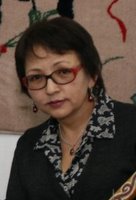 Books are eternal. No Internet can ever compete with a product of the printing press - it is forever. For posterity. There is an event that represents a milestone for Tuva, and for Turkologists of the entire country and of the world: a massive work of a collective of authors has just been published - Nikolai Katanov's "Sketches of the Uriangkhai country".
Books are eternal. No Internet can ever compete with a product of the printing press - it is forever. For posterity. There is an event that represents a milestone for Tuva, and for Turkologists of the entire country and of the world: a massive work of a collective of authors has just been published - Nikolai Katanov's "Sketches of the Uriangkhai country".
It is a diary of Nikolai Fedorovich's travels "undertaken in 1889 on assignment by the Imperial Academy of Sciences and the Imperial Russian geographic Society" - an extremely interesting record about the ways of life and existence of the ancestors of today's Tuvans. The notes were recorded daily during the exploration of the center of ASIA, FROM 13 March TO 3O August. And already one month after the end of the expedition, on 26 September, the manuscript was ready for publication. But…
The 19th century ended, even the 20th has gone by. The author of the sketches has long been dead. Only now in 21st century this interesting work of a scientist with a name of world renown is finally reaching the wide readership. And we definitely have to name the person who was instrumental in making this possible: Ailana Kuzhuget.
Ailana Kalinovna was on a working assignment in Sankt-Peterburg in 2003 at the famous Kunstkamera of the Peter the Great Museum of Anthropology and Ethnography. The manuscript of the "Sketches…" was kept - and is kept to this day - precisely here; some of our compatriots, but only very few of them, have been able to see it during the last century.
Kuzhuget knew about this work of Katanov from quotes in S. I. Vainshtein's publications. And suddenly she got this idea: to go to the administration of this educational center, and beg, even on her knees to get the writings fro publication in Tuva. The director, Doctor of historical sciences Yuri Chistov, approved it. In this way, a copy of this voluminous manuscript turned up in Tuva.
 Preparations for publication started. It has to be said that Ailana Kuzhuget has already had a similar experience: the publication of "Traditional culture of Tuvans through the eyes of foreigners (end of 19th - early 20th century)" in 2003, and "Uriangkhai region in 1915" by Alexei Turchaninov in 2009, which had already become rarities. The third book in this "series" was created with the help of several people, with love and enthusiasm.
Preparations for publication started. It has to be said that Ailana Kuzhuget has already had a similar experience: the publication of "Traditional culture of Tuvans through the eyes of foreigners (end of 19th - early 20th century)" in 2003, and "Uriangkhai region in 1915" by Alexei Turchaninov in 2009, which had already become rarities. The third book in this "series" was created with the help of several people, with love and enthusiasm.
Inna Saganol studied the not very legible handwriting of the scientist and typed the text on a computer. Ailana Kalinovna put the collection in order, and prepared the introduction and commentaries. She read it and - cried, imagining the hard life of her ancestors under the Manchu dynasty. Monstrous conditions: they made the Tuvans buy already used tea leaves or spoiled fabrics. It was permitted to punish Tuvans physically for one contact with foreigners, namely with Katanov… The "sketches…" contain not just ethnographic material about the Uriangkhai, but also about Russians of that time. The book is illustrated with Katanov's original drawings from the manuscript; he turned out not to be a bad artist either. And that adds value to the publication.
It is here that the last article of Doctor of philology Boris Tatarintsev "N. F. Katanov and his "Sketches of the Uriangkhai Country"". Boris Isakovich adored this remarkable scholar and scientist - he considered him a friend. That is how much he valued the explorer's work - with whom he could never meet in real life. Doctor of philology Svetlana Orus-ool also helped with the undertaking; she herself offered to write, especially for this book, an article "N. F. Katanov - collector of Tuvan folklore". And a candidate of philology Kyzyl-Maadyr Simchit voluntarily wished to put together the "Index of names" - an extremely detailed kind of work.
In 2005 the manuscript was ready for publication. But there simply was no money for the printing. Ailana Kuzhuget was forced to take a loan to bring the work to a successful conclusion. You have to agree that this is an extraordinary thing to do. A profound bow to her for devotion to the work.
The book was printed in Abakan in an issue of 1000 specimen. The computer page-proofs and editing was done by Anna Kazantseva. We think that this new publication will be of interest not just to scholars, but to ordinary readers of all ages as well: who wouldn't like to travel in time?
It is such a lovely present to all of us for the 90th Anniversary of TNR. Next in line are two large volumes of unpublished works of Innokentiy Safianov. Ailana Kuzhuget was helped with this work by her colleagues from Tuvan Institute of Humanitarian Research, Doctor of historical sciences Nikolai Mollerov and Candidate of philology Margarita Tatarintseva. The financial support comes form Safianov's grandson, Vladimir Mazo, a Muscovite. The books should be brought to Kyzyl by 11 August - a present to the region for the anniversary of the founding of Tuvan People's Republic.

